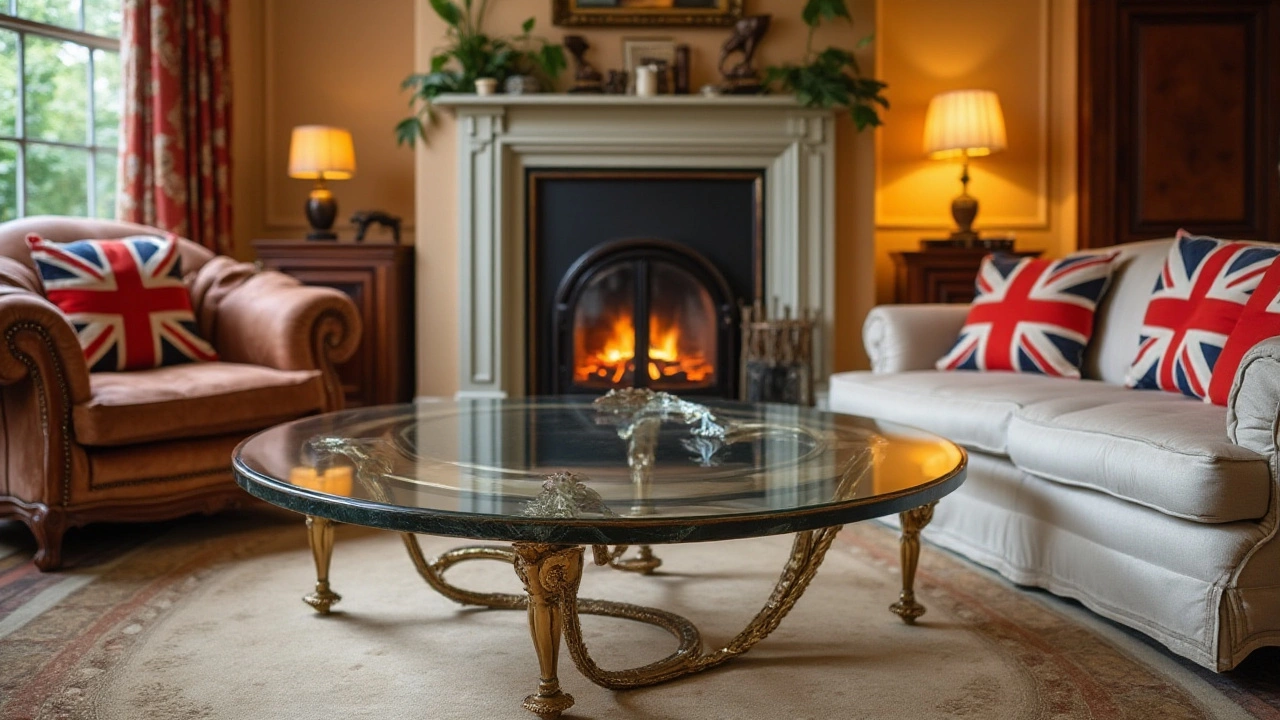Deciding on the right coffee table for your living room can be a delightful yet daunting task. If you're torn between glass and acrylic, you're not alone. Both materials have become quite the contenders in the world of home decor, each bringing their own charm and functionality to the space they adorn.
Glass coffee tables have been a timeless choice, celebrated for their elegant transparency and the way they fit seamlessly into a room without overwhelming it. They speak sophistication and provide a certain crisp clarity to your interior. Meanwhile, acrylic coffee tables have been increasingly making waves for their modern edge and practical functionality, all while being surprisingly lightweight and versatile.
To help steer you in the right direction, we'll delve into the characteristics, appeal, and practical aspects of both materials. Whether you lean towards the traditional allure of glass or the contemporary vibe of acrylic, this guide will help you make an informed choice for your haven.
- Material Characteristics
- Aesthetic Appeal
- Durability and Maintenance
- Cost and Value
- Suitability for Different Spaces
Material Characteristics
When considering a glass coffee table for your home, the first thing that probably comes to mind is its pristine, reflective surface. Glass is made by fusing sand with soda and lime at incredibly high temperatures. This process results in a material that’s not only transparent but also quite sturdy. You've likely noticed that glass tabletops can appear thinner yet support a fair amount of weight without losing their integrity. This is due to advancements in manufacturing that have introduced tempered glass options. Tempered glass is especially prized in households with children or pets since it's crafted to shatter into small, less dangerous pieces if broken.
Acrylic, on the other hand, offers something a bit different. Often referred to as Plexiglas, acrylic is a type of plastic that boasts high durability and shatter resistance. It’s created by polymerizing methyl methacrylate, a process that results in a material that's surprisingly lightweight yet tough. This weight advantage means acrylic coffee tables can be easily moved around the room, a boon for those who enjoy rearranging their decor regularly. While not as impervious to scratches as glass, acrylic has the benefit of being less brittle. For this reason, it’s less likely to chip or crack under stress, which is a significant consideration if your coffee table will endure lots of activity.
When it comes to thermal properties, it’s interesting to note that acrylic has a lower thermal conductivity than glass. This means that, under normal room conditions, acrylic tends to stay a bit warmer to the touch. It may seem like a small feature, but this can add to the cozy ambiance you might desire from your living room furniture. For anyone looking into energy-efficient home design, this property might intrigue you.
With both materials offering unique qualities, choosing between them often boils down to personal preference and practical needs. According to interior designer Sasha Bikoff, "Acrylic offers a futuristic vibe with a nod to mid-century modern styles, while glass remains timeless in its appeal."
Merriam-Webster defines acrylic as 'a type of glassy transparent plastic used instead of glass.'It’s fascinating to think about how these two distinct paths converge at the same purpose: elevating your space with style and substance.
Perhaps you’re curious about the environmental impact of these materials. Traditional glass can be recycled endlessly without losing quality, making it an eco-conscious choice. Acrylic, while less friendly to biodegradation, can be repurposed through mechanical recycling or converted into fuel, though this process is less common. Weighing these factors might be important if sustainability is a significant concern.
Aesthetic Appeal
When it comes to the aesthetic appeal of glass coffee tables versus acrylic coffee tables, both bring something unique to the living room palette. Glass tables offer a sense of timeless elegance. Their crystal-clear surfaces create a sense of openness in any room, making them ideal for spaces where you want to emphasize light and airiness. The reflective nature of glass enhances the feeling of space, often making a small room feel much larger. This quality is not just limited to visuals; glass tables somehow carry the essence of transparency and straightforwardness, both literally and metaphorically.
In contrast, acrylic tables usher in a sense of sleek modernism. Made from a transparent thermoplastic, these tables almost seem to float in the room due to their light yet sturdy construction. This can create a stunning visual effect where other elements of the decor take center stage without visual blockage. The beauty of acrylic lies in its versatility. Whether your living space leans towards the rustic with wood or is more modern with clean lines and metallic surfaces, an acrylic table can effortlessly blend in and complement various styles, adding a trendy touch without overdoing it.
Another defining feature of acrylic coffee tables is their ability to be colored or tinted, offering a broader range of customization compared to their glass counterparts. This feature can be particularly beneficial when you're trying to match or accentuate other elements in your home decor. A clear acrylic table can remain unobtrusive in a vibrant room, whereas a tinted one might bring a subtle hue that ties the whole space together, giving it a cohesive look.
There's an age-old debate about whether it's style or substance that holds more importance. According to a design article by 'Architectural Digest', "The best furnishings should marry both beauty and practicality."
"Choosing materials that both look good and fit the functionality of your household is key," said renowned interior designer Sophia Williams, "Glass offers sophistication but may weigh more, while acrylic is versatile and easily adaptable."In terms of safety, especially in homes with kids, acrylic wins hands down as it shan't shatter as easily as glass, making it a preferred choice for those seeking safety without sacrificing style.
To summarize, both these materials boast unique aesthetic traits that cater to different tastes and lifestyles. Glass coffee tables are perfect for those who prize classic beauty and understated elegance, allowing a seamless blend with formal spaces. Meanwhile, acrylic coffee tables, with their contemporary vibe and versatility, cater more to those who enjoy experimenting with modern or eclectic styles. Ultimately, your choice should reflect the mood and function of the space you're designing, ensuring both beauty and practicality are well-balanced.

Durability and Maintenance
When it comes to picking the perfect table for daily use, durability, and maintenance are crucial factors to consider. Think about the natural differences between glass coffee tables and their acrylic counterparts. Glass, by its nature, is beautiful yet fragile. Its charm lies in its elegance, but this comes with the caveat that it can be prone to scratches or shattering if something hefty topples over. It's essential to have a bit of caution, especially in bustling homes or places with kids and pets moving around.
Acrylic tables, on the other hand, have a sturdy reputation. They are tough yet flexible, which really helps when dealing with accidental hits and casual wear and tear. There's a surprising resilience to acrylic that's hard to beat by standard glass. It might scratch more easily than glass, but it won't splinter into many shards if disaster strikes. This makes acrylic the more forgiving option for those unexpected moments that life sometimes throws your way.
In terms of maintenance, glass tables require regular cleaning to maintain their sleek appearance. Dust and fingerprints are quite visible on glass, which may necessitate frequent sprucing up with specialized glass cleaners. Contrast that with acrylic, where routine maintenance tends to be a little simpler. A mild soap and water solution usually does the trick, avoiding any harsh chemicals that could haze or damage the surface. As with any material, care goes a long way in keeping it looking new and fresh.
To echo a sentiment from renowned interior design expert Jane Cameron, "In the art of furniture, knowing what is durable yet captivating is key to a harmonious living space."
"Choosing between material involves weighing practical considerations with the aesthetics desired." — Jane Cameron, Interior Design Expert
The critical decision between glass and acrylic often lies in personal preference paired with the demands of their environment. Avid entertainers or families bustling with energy might find the utility of an acrylic table appealing, whereas those aiming for a refined, meticulous look might gravitate toward the timeless elegance of glass.
Interestingly, surveys have shown that households with children often favor the use of acrylic tables over glass due to fewer incidents of breakage. This goes to show that preferences exist not only on aesthetic grounds but practical needs as well. Whatever you choose, remember that both materials, with the right care, can outlast trends and stand the test of time.
Cost and Value
When pondering over the decision of investing in a new coffee table, one crucial aspect is balancing cost with value. In this world of home decor, both glass coffee tables and acrylic coffee tables present unique investment considerations. Glass tables have been traditionally viewed as more luxurious, often linked to designs flaunting intricate craftsmanship. This perceived opulence sometimes puts them on the higher end of the price scale, depending on the brand, design intricacies, and thickness of the glass.
Acrylic tables, on the other hand, are often marketed for their budget-friendly nature. Despite having a modern flair similar to glass, they don’t typically carry the same weight in terms of cost. The production process of acrylic is generally less expensive, which can mean savings passed on to the consumer. However, it's worth noting that there's variability depending on the design and craftsmanship involved in some high-end acrylic pieces.
"Price should not solely determine choice; think of the value it brings to your living space," advises interior designer Emma Lawton, emphasizing the need for balance between aesthetics and financial considerations.
Now, let's talk about durability in relation to cost. Glass tables can offer longevity, which in turn, may provide better long-term value. Despite their delicate reputation, tempered glass is notably strong and resistant to scratches making it a durable option in the right circumstances. Acrylic, while durable as well, is more prone to scratches and can become clouded over time if not cared for properly. Some might argue that the risk of damage to glass might make acrylic a better value choice, especially in households with active kids or pets.
For a practical buyer, it’s essential to assess not just the upfront cost, but how each piece will wear over the years and retain its aesthetic charm. Making the most out of your budget might mean opting for bespoke acrylic works that, while more costly than mass-produced alternatives, bring forth an added layer of style and functionality. Sometimes, it may be an investment in maintaining timeless aesthetics, like a well-chosen glass piece, that pays off in spades.
To encapsulate these nuances, here’s a brief outlook on potential prices:
| Type | Price Range | Durability |
|---|---|---|
| Glass Coffee Tables | £200 - £1000+ | High |
| Acrylic Coffee Tables | £100 - £700+ | Medium |
In conclusion, both styles offer distinct economic and practical advantages. As a homeowner, weighing these against personal style and everyday functionality will determine the best choice for your unique space.

Suitability for Different Spaces
Choosing the right coffee table can elevate the ambiance of your living area, balancing functionality with elegance. Understanding where each material fits best can help blend harmony into your home decor. Glass coffee tables are often celebrated for their versatility in smaller spaces. They introduce a sense of openness, allowing light to pass through and creating an illusion of a larger area. This can be particularly beneficial in cramped or dimly lit rooms, where every square foot matters.
Imagine a cozy nook, with sunlight streaming through the windows; a glass coffee table will catch that light, casting playful reflections around, enhancing the room's warmth and charm. Yet, an interesting aspect to consider is safety. Glass tables, while stunning, do require a bit of caution, especially in homes with young children or pets. Sharp corners can be dangerous and the material itself, though strong, can shatter under significant pressure or impact.
In such homes, an acrylic coffee table might be a safer alternative. Acrylic offers a softer aesthetic, usually without any sharp edges that could pose threats. It's also incredibly light, making rearranging or cleaning under them a breeze. Moreover, acrylic tables resist shattering, which makes them a favorable choice for high-traffic areas or homes where safety is a primary concern. Many designers appreciate acrylic for its ability to mimic the transparency of glass while offering a host of additional practical benefits.
"The choice between glass and acrylic often boils down to safety, practicality, and personal style," states interior design expert Jane Smith in Contemporary Living Magazine. "Acrylic tables have revolutionized modern decor with their lightweight, adaptable nature."
For open-plan living spaces or larger rooms, where bold design statements are welcome, mixing both materials can be an option. Combining a glass coffee table with acrylic side tables could create an eye-catching contrast and allow homeowners to enjoy the best of both worlds. Consider a spacious living room making use of different materials for accent and secondary tables, adding layers and dimensions to the space.



